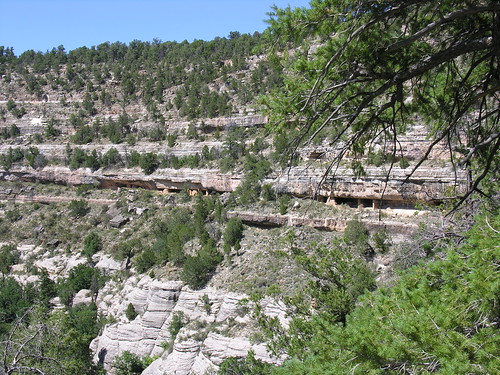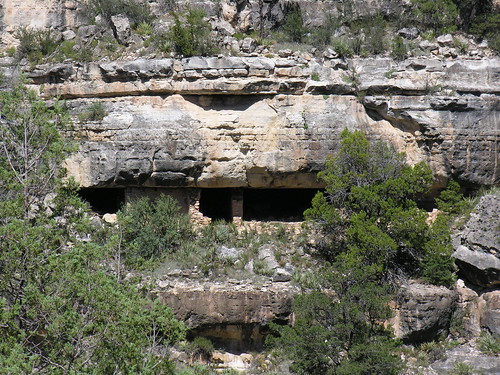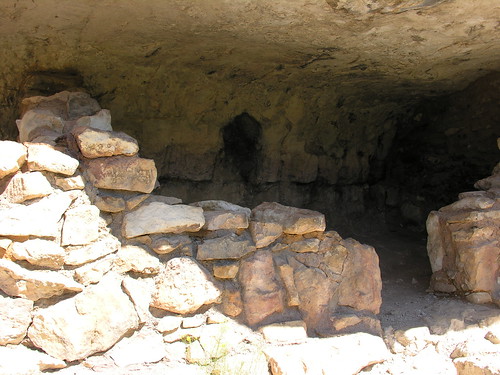Walnut Canyon: Very Healthy Ancient People
Posted in Historic, National Park, Scenery, Southwest, Travel | By Shelley Gillespie | Tags: Caves, Hiking, National Park, Scenery, Southwest, Travel
When we visited Walnut Canyon National Monument this past weekend, we were alerted that there were 240 steps down – and up – from the visitor center to the Loop Trail where we could see the homes of ancient people carved out of steep hillsides.
240 steps – each way, up and down – was quite a strenuous trip to reach the top! When Sinagua people inhabited the cliff dwellings of Walnut Canyon 800 years ago, they must have been part mountain goat – and they didn’t have paved steps and paths! Although I consider myself fairly physically fit, the altitude, 7,000 feet, coupled with the demanding climb of 185 feet, I reached the visitor center panting with my heart pounding.
So, was the climb worth it? Absolutely! The information about Walnut Canyon said that we would see 25 cliff dwellings. Although I didn’t count, it amazed me to see the cliff homes. How the Sinagua (Spanish – “without water”) made homes out of the overhangs formed by the elements showed their ingenuity. They added side and outer walls, creating a place where they stored the water and food they needed. Fires created dark, ashy residue on the upper walls.

Cliff dwellings from a distance

Cliff dwellings - ancient condos?
We could walk right up to the dwellings and see where whole families lived. As we walked the almost one mile loop (at the base of the 240 steps), we saw displays explaining plant life and details of how the Sinagua lived. We joked about how since one side of the loop was sunny and the other shady, maybe the ancients headed to the sunny side as a migration for better climate. Not too different from the modern Arizona snowbirds, we thought.

Cliff dwelling up close - note the fire residue
At the visitor center, there is a stairway leading down to the Loop Trail. The Park’s Ranger gives a non-intrusive glance as people head outside. One hour before the park closes, people are not allowed to begin the loop trail.
Note: They say it takes one hour to complete the Loop Trail. We arrived back at the visitor center at 56 minutes (we took lots of photos and paused to read the displays, too), panting and wobbly. Blame it on the altitude!
In addition to the Loop Trail, there is a Rim Trail. It is, according to the National Park’s Web site, “fairly level” and “easy.” At only .7 miles, paved and accessible in the first section, the Rim Trail had a lot of visitors. It provides views of two canyons, a pit house and pueblo. Thirty minutes before closing the trail is closed to new visitors.
The one sad commentary about the cliff dwellings was one display that explained how visitors used to loot the abandoned cliff dwellings (vacated 800 years ago, archaeologists think, due to drought). One account contained a list of items that had been taken – quite a catalog of how the ancients had lived -
“cornstalks, corn cobs, beans, gourds, nuts, reeds, arrows, bowstrings, coarse cloth, a child’s sandal, measuring stick with notches, bone needles, fish line, soapwood needles, broken pottery” and more.
The Sinagua cultivated crops, hunted, sewed, fished and created pottery. More modern inhabitants of the area had no sensitivity to the value of the archaeological finds. When President Teddy Roosevelt came to the rescue and put Walnut Canyon under the protection of the national government in 1915, people could no longer loot and vandalize with impunity. Bravo, Teddy!
Visitor Center Hours
Park entrance road, trails, and Visitor Center are open all year, except December 25.
Hours:
November – April 9:00 AM – 5:00 PM MST
May – October 8:00 AM – 5:00 PM MST
Entry to park trails closes 1 hour before the monument closes.
Take Interstate 40 for 10 miles east from Flagstaff and take exit 240. Then travel 3 miles to the park entrance. Admission is $5 per person.
Tags: Caves, Hiking, National Park, Scenery, Southwest, Travel
